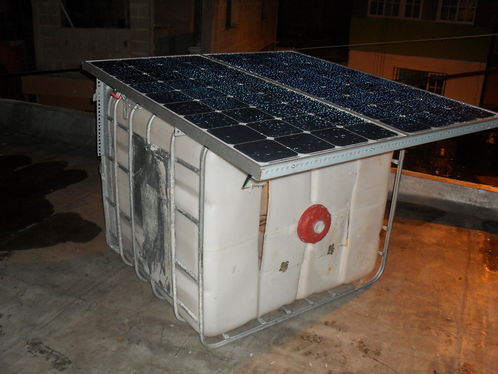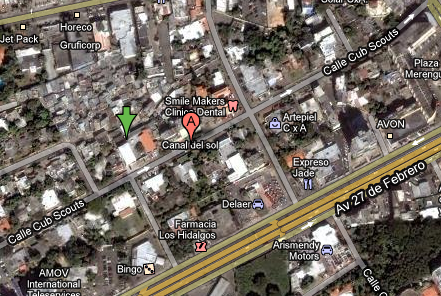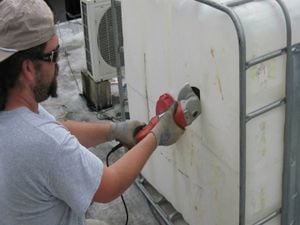
Objective Statement
The objective of this Appropriate Technology project was to develop and construct a renewable energy system with Ghetto2Garden dog shelter program to fuel part of the shelter. We worked on putting together renewable energy for Ghetto2Garden to not only have a more dependable source of energy but to lessen carbon emissions. The renewable energy system will eventually be used to power a vaccination refrigerator, and other miscellaneous units such as cell phone chargers and laptops. It turned out that solar energy was the most accessible and appropriate technology for Ghetto2Garden. The project consisted of two parts; Building a "Solar Power Cube", and constructing a "Solar Lighting Cube."
Background
The streets are not the most suitable habitat for animals to live in. Animals are especially vulnerable when they need rehabilitation, recovery, and rest. Ghetto2Garden takes care of cats and dogs with reduced potential for adoption; that are deformed, blind, unwanted, elderly, and/or are terminally ill.
The Ghetto2Garden initiative was developed initially in an attempt to find an appropriate shelter to house 6 cats and 40 dogs. Currently Ghetto2Garden houses 50 dogs and 10 cats who have been rescued from the streets of Santo Domingo and provides these animals with a care facility where they can live the rest of their days in peace and happiness. This student involvement in this project is the result of the collaboration between Colectivo Revark and the Practivistas Dominicana program in an attempt to bring sustainable construction and renewable energy to the construction of the shelter.
Location
Because Ghetto2Garden was in the process of finding a new site for the animal refuge, the project took place in La Yuca.
La Yuca del Naco, Santo Domingo, Dominican Republic

Criteria
Table 1: Criteria
| Criteria | Weight (0-10) | Constraints |
|---|---|---|
| Aesthetics | 5 | Must be acceptable to the client's vision |
| Durability | 7 | Maintenance must be simple with few necessary repairs |
| Mobility | 5 | Must be transportable to the location, partial set-up before arrival |
| Feasibility | 9 | Must be able to complete it, with easy construction within the time frame |
| Creativity | 8 | Must reflect the creativity shown in architectural plans |
| Energy Produced | 10 | Must be at least able to steadily produce 200 watts |
| Cost | 7 | Must be less than $1000 US |
| Security | 10 | Must be unobtrusive and obviously well secured |
Solar Power Cube
Colectivo ReVark, an experimental group that investigates applications of sustainable design and construction, designed a animal refuge for Ghetto2Garden. This animal refuge is designed to incorporate liquid shipping cubes as dog kennels which were coincidentally designed to double (or triple) as solar lighting cubes and a solar power cube. Other forms of alternative energy were considered, but solar energy turned out to be the most accessible and appropriate technology in this case.
Design and Construction Process

Design
Construction
Materials used:
- Liquid shipping container
- Solar panels
- Invertor
- Solar Charge Controller
- Deep Cycle Batteries
- Switch
- Wire
- Metal Bars
-
Figure 5a: Liquid Shipping Container
-
Figure 5c: "Control Board"
Components
| Device | Specifications | Description | Picture |
|---|---|---|---|
| Solar Panels | Two 140W Panels in parallel | Used to charge Two 6V batteries in series with 225AH | [[Image:|thumb]] |
| Fuse | 35A Fuse | The fuse is used to protect the elements of the circuit | [[Image:|thumb]] |
| Solar Charge Controller | 12/24V
30A |
The Solar Charge Controller protects the batteries from being destroyed by the solar panels by opening the circuit when they are fully charged. Furthermore, it regulates the amperage at which the batteries are charged. | [[Image:|thumb]] |
| Switch | 30 Amp | The Switch is used to disconnect the batteries from the system if needed. | [[Image:|thumb]] |
| Deep Cycle Batteries | Two 6V in series
225AH |
The Batteries will be used to power a vaccination fridge and other miscellaneous uses. | [[Image:|thumb]] |
| Invertor | 200W
12V |
Used to convert Direct Current to Alternating Current. | [[Image:|thumb]] |
Cost
Budget
| Materials | Unit Price (DOP) | Quantity | Cost (DOP) | Cost (USD) | Our Actual Cost (DOP) | Our Actual Cost (USD) |
|---|---|---|---|---|---|---|
| 10 watt Solar Panel | 2,850 (1,710 donated) | 1 | 2,812 | 75 (45 donated) | 1,125 | 30 |
| Gears | 410 | 1 | 410 | 10.93 | 410 | 10.93 |
| Permanent Magnet Motor and Shunt | 1,500 | 1 | 1,500 | 40.00 | 1,500 | 40.00 |
| Battery and Terminals | 1,870 | 1 | 1,870 | 49.86 | 1,870 | 49.86 |
| Diodes, Switches, and Zeners | 50 | 1 | 50 | 1.33 | 50 | 1.33 |
| Inverter | 1,400 | 1 | 1,400 | 37.33 | 1,400 | 37.33 |
| Solar Charge Controller | 1,300 | 1 | 1,300 | 34.67 | 1,300 | 34.67 |
| LED lights | 55.50 (donated) | 27 LEDs | 1,498.50 | 39.96 | free | free |
| Electrical wire | $5/ft | 300ft | 1,500 | 40 | 1,500 | 40 |
| Turbine (construction labor) | $20,000 (donated) | 1 | 20,000 | 533.33 | free | free |
| Black Metal Pipe | 635 | 1 | 635 | 16.93 | 635 | 16.93 |
| Angular Iron | 2,435.47 | 1 | 2,435.47 | 64.95 | 2,435.47 | 64.95 |
| Total = | $35,411.47 | $944.31 | $12,225.47 | $326.01 |
Solar Lighting Cube
Design and Construction Process
Construction
Materials used:
Components
Cost
Budget
Timeline
| Date | Activity | Members |
|---|---|---|
| June 17 | Criteria & Timeline Due | Everyone |
| June 20 | All research on Batteries, inverters, and complete construction process (including soldering) must be complete and uploaded to Appropedia. Also research the best angles for light to hit solar panels for max output. | Everyone |
| June 22 | Must have a meeting with Tomas by this date | Everyone + RevArc |
| June 23 | Make sure all materials and equipment is bought | Simone & Will |
| June 28 | Complete first panel and figure out optimal method of attachment. | Everyone |
| July 1 | Project completed | Everyone |
| Week of July 1 | Presentations | Everyone |
Literature Review
See the literature review here.
